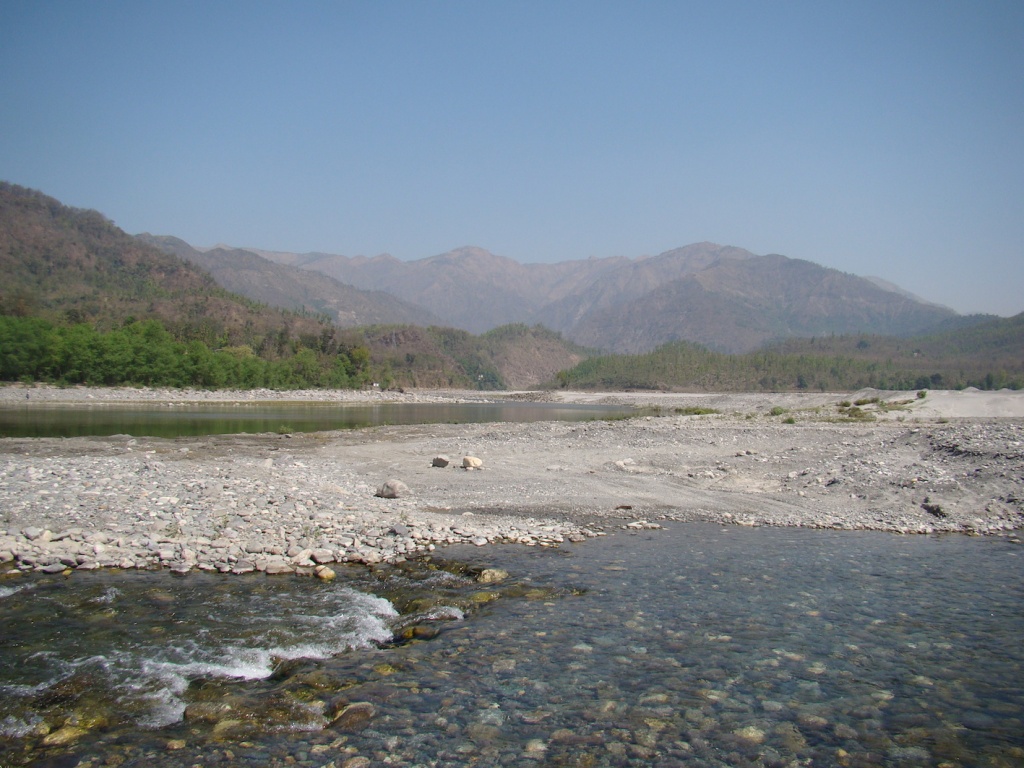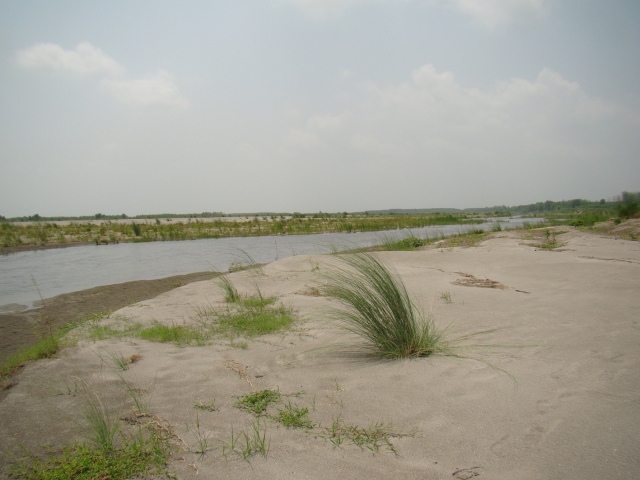River Floodplains are not vacant wastelands awaiting tree plantations. They are extensions of a flowing river with key roles for keeping it healthy.
‘Afforestation’ has been cited as one of the key components of the ongoing Rs 20,000 Crores ‘Namami Gange’ program launched with much fanfare by the Modi government for the rejuvenation of river Ganga. Forestry interventions for Ganga rejuvenation are reportedly underway in accordance with a Detailed Project Report (DPR) prepared by the Dehradun based Forest Research Institute (FRI).
A recent post on twitter by Dr V N Mishra has questioned the wisdom of local forest department planning to raise trees in the active floodplain of river Ganga in Varanasi.
Earlier this writer has also critiqued the plans of the Delhi Development Authority (DDA) to parcel out portions of Yamuna floodplains in Delhi to the forest department to raise compensatory plantations in lieu of trees felled or to be felled at the altar of developmental projects like Metro, Roads, flyovers, bridges etc. in Delhi.
An underlying presumption in these and similar tree plantations underway or planned in active floodplains of rivers seems to be that this is a benign, desirable, harmless and worthy activity. We think it’s otherwise. Let me explain.
What is a river floodplain?
Such lands on either bank of a flowing stream that go under water during floods for brief or longer duration and on a regular basis are termed its floodplains. These land forms are an integral part of a river system as they play an important role in stream ecology.
In a monsoonal climate like south Asia, marked by extremes in stream flows from high to very high during monsoon to low to very low later in rest of the year, these lands at first glance are often presumed to be lying waste or fallow. It’s only a closer and a scientific look that helps one decipher its usefulness.
Interestingly the Ganga Authorities Notification of October 7, 2016 by the Union Ministry of Jal Shakti has defined “flood plain” under section 3 (1) (l) as “such area of River Ganga or its tributaries which comes under water on either side of it due to floods corresponding to its greatest flow or with a flood of frequency once in hundred years”.
The same notification has gone on to define “River Bed” under section 3 (1) (s) as “the dried portion of the area of River Ganga or its tributaries and includes the place where the River Ganga or its tributaries run its course when it fills with water and includes the land by the side of River Ganga or its tributaries which retains the water in its natural channel, when there is the greatest flow of water.”
The short message from above is that what might around rivers look dry and drab land for some part of the year is not so and cannot be treated as wasteland, “awaiting development” (sic).
It’s a pity when people tend to ignore ‘flood’ in the term ‘floodplains’ and look upon it as ‘available’ lands.
Physical and Ecological significance of floodplains
Floodplains of a river provide it the necessary flexibility to exhibit its dynamic waxing and waning personality. It acts as a safety net within which a river shall limit itself and behave without disturbing anyone else, living or not.
In human terms, it’s like a large bed on which you have the liberty to toss and turn. This is quite like what a river like Ganga or Yamuna does as it meanders or play fully changes course at will after some of their major floods. Often leaving behind in curving ox bow lakes (that abound in flood plains), tell tale signs of where it once flowed and could flow yet again.
Rivers in south Asia bring humongous loads of sediment annually from their catchment that gets deposited as boulders, gravel, sand or silt and the floodplains play perfect host for it all.

For their base flows during the non-monsoon months, rivers (especially those not benefiting from glacial melt) need to be fed by aquifers lying in the floodplains. This is something in nature of a return gift since the very river during floods had saturated those aquifers. But this is possible only when there is sufficient water in the aquifers and it has not been pumped away. Here lay the reason for our objecting to the proposal to raise tree plantations in the floodplains.
Lest anyone get an impression that floodplains are devoid of any vegetation or other life forms, the facts are otherwise. They carry very distinctive vegetation and animal life forms but of which trees are far and few.
Why tree plantations in floodplains are ecologically out of place?
A river as it tumbles down the hills creates various kinds and sizes of floodplains.
In the hills, these are restricted within valleys marked by steep slopes on either bank. River bed consists of boulders and gravel and at places bed rocks get exposed and are continually eroded. In deep portions or sharp bends in the valley even sand banks can be found. Vegetation in these stretches is a mix of shallow rooted grasses, herbs and shrubs, many of which have medicinal value for humans. Just as a river is exiting the well defined valleys in the hills to open into vast plains and gets into a leisurely paced flow rhythm often tree groves of species like sissoo (Dalbergia sissoo) and khair (Acacia catechu) could be found in stretches of floodplains. Otherwise most trees in the hilly river valleys are found sticking onto the hill slopes.

It may be noted that both Sissoo and khair are shallow rooted tree species and hence remain subject to vagaries of floods. We are witness in 2012 of an overnight disappearance of a sissoo – khair patch by a flash flood in river Yamuna near Katapathar in Uttarakhand.
Once a river enters plains it begins to spread laterally into braided channels and to form large floodplains sometimes spreading over several kms on either bank. Such floodplain soils are essentially alluvial deposits where sand predominates. Morphologically the floodplain here is continually in a flux and sometimes sees dramatic transformations with time and with changing flood intensities.

According to Prof Brij Gopal et al (2007) “River islands are an important feature of the Yamuna flood plains. They are formed by deposition of huge amount of sediments in the river bed. Some of these islands are very large in size. There was an extensively large island near Patthargarh village in Panipat district covering an area of about 820 hectares in 2002. However, there was no such island in 1970”.
Now whenever such changes happen (and this happens often) it is the pioneers like grasses and sedges that take root and in due course give way to herbs and shrubs. By the time ecological processes could begin to favor tree growth it is time for another drastic morphological transformation and hence in vast floodplain stretches of rivers, trees in large congregations (what a plantation would entail) are hard to find. It’s only towards the deltaic stretch of a river that proper tree forests in form of ‘mangroves’ are found resulting from special soil, water and climatic conditions.

Thus we normally do not come across vast forest stretches in active alluvial floodplains of large rivers. To plant trees in them would thus be incorrect. This is notwithstanding the risk of an episodic flood event which could wipe out overnight any such plantation, even if raised successfully, bringing to naught all the investments and efforts. In case physical barriers are raised to safeguard the plantation area from riverine fluxes then it shall be akin to slicing away a part from the river bed which shall not find legal or ecological sanctity.
Transpiration
Transpiration as we know is the process of water movement through a plant and its evaporation from aerial parts, such as leaves, stems and flowers. All plants transpire and transfer water from soil to the atmosphere. It has been estimated that more than 95% of all water that a plant sucks from the ground is not utilized by it for its growth or metabolism and is ‘lost’ to transpiration and guttation.
A tree with deep roots is a virtual water pump drawing water from the aquifer like from any well, hand pump or a deep bore well with electric pump. And a large number of trees in the floodplain would only pauperise the floodplain and its aquifers water, which is otherwise meant to ensure base flow in the river. One of the key roles of sandy floodplains is to maintain water table high enough to meet the needs of river during its lean period. But if the floodplains are planted up with trees desiccation of aquifers would be an obvious consequence.
But are there not grasses, sedges, shrubs and herbs to be found in the floodplains? Yes, indeed. But these are all mostly seasonal and small sized in comparison to a tree, their water needs are small and being shallow rooted these hardly ever reach the water table remaining largely content with the soil moisture.
Thus any “Afforestation” where trees are raised in active floodplains of rivers like Ganga and Yamuna presuming it to be benign and a desirable activity is grossly misplaced and should be avoided.
The so called forestry intervention for the rejuvenation of rivers like Ganga should focus on the re-vegetation (which does not mean tree plantations alone) of degraded catchments aimed at the revival of springs and waterfalls which shall be the true and sustained means by which our rivers could flow once again.
Manoj Misra, a former forester, is the convener of Yamuna Jiye Abhiyaan.
This story has been sourced from SANDRP.


















